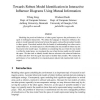Free Online Productivity Tools
i2Speak
i2Symbol
i2OCR
iTex2Img
iWeb2Print
iWeb2Shot
i2Type
iPdf2Split
iPdf2Merge
i2Bopomofo
i2Arabic
i2Style
i2Image
i2PDF
iLatex2Rtf
Sci2ools
87
Voted
WIAS
2010
2010
Model identification in interactive influence diagrams using mutual information
Modeling the perceived behaviors of other agents improves the performance of an agent in multiagent interactions. We utilize the language of interactive influence diagrams to model repeated interactions between the agents, and ascribe procedural models to other agents. Procedural models offer the benefit of understanding how others arrive at their behaviors. As model spaces are often bounded, the true models of others may not be present in the model space. In addition to considering the case when the true model is within the model space, we investigate the case when the true model may fall outside the space. We then seek to identify models that are relevant to the observed behaviors of others and show how the agent may learn to identify these models. We evaluate the performance of our methods in two repeated games and provide experimental results in support.
Related Content
| Added | 23 May 2011 |
| Updated | 23 May 2011 |
| Type | Journal |
| Year | 2010 |
| Where | WIAS |
| Authors | Yifeng Zeng, Prashant Doshi |
Comments (0)

